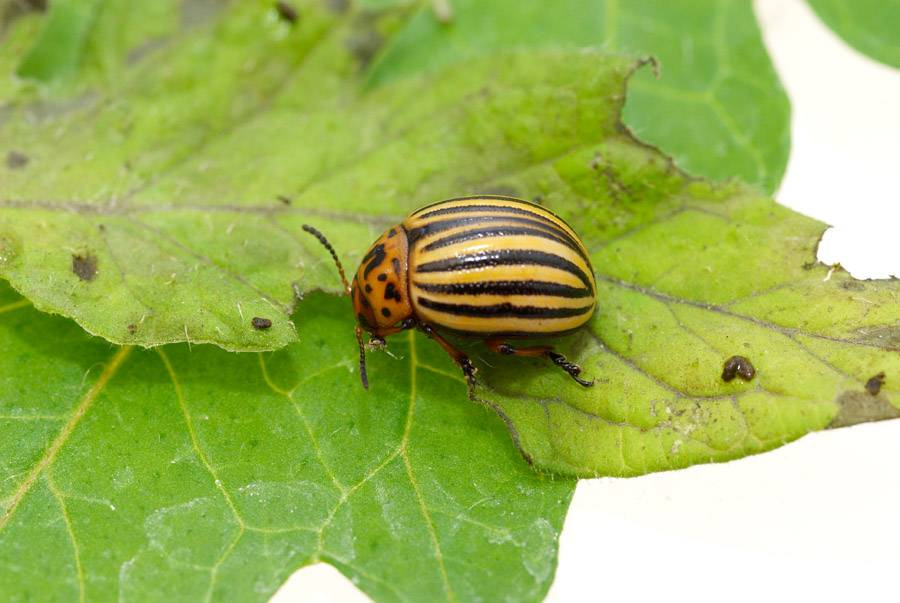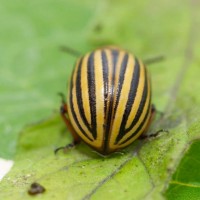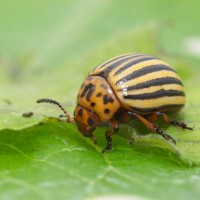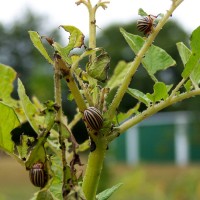
Colorado Beetle - Leptinotarsa decemlineata
Expand and collapse the sections below by clicking on the title or + / - icons.
Short description of Leptinotarsa decemlineata, Colorado Beetle
Colorado potato beetleis a distinctive yellow beetle with ten longitudinal stripes on the wing cases. Adults are up to 11mm in length. This species is a highly destructive notifiable quarantine pest of potato (plus tomato and peppers), with the potential to greatly reduce yields.
Impact summary: Leptinotarsa decemlineata, Colorado Beetle
Colorado potato beetle adults and larvae feed on plant foliage, devouring entire leaves. Feeding on stems and exposed tubers can also take place to some extent once the foliage has been consumed. The species is the most serious pest of potato (and affects other plants in the family Solanaceae, e.g. tomato and peppers), with the potential to greatly reduce yields (50% potato crop losses can occur in Europe).
Habitat summary: Leptinotarsa decemlineata, Colorado Beetle
In its introduced range Colorado potato beetle inhabits arable land and cultivated gardens and parks. In addition to crop species (particularly potato), the species can live on other (wild-growing) plants in the family Solanaceae as a refuge. In its native range the species is found in broadleaved deciduous woodland.
Overview table
| Environment | Terrestrial |
|---|---|
| Species status | Non-Native |
| Native range | Northwestern U.S.A., Mexico |
| Functional type | Herbivore |
| Status in England | Non-Native |
| Status in Scotland | |
| Status in Wales | |
| Location of first record | Liverpool Docks |
| Date of first record | 1877 |
Origin
Colorado potato beetle is native to Mexico.
First Record
Colorado potato beetle was first recorded in GB in 1877. There have been many further outbreaks but the species has been eradicated at least 163 times. The last major outbreak was in 1976. It was first recorded outside of its native range in 1811 (USA).
Pathway and Method
International trade, such as fresh vegetables from infested areas. In GB most commonly intercepted in spring or early summer from Europe on plant produce (e.g. salad vegetables, potatoes, parsley).
Species Status
Colorado potato beetle is a notifiable quarantine pest in GB. The species is established in much of continental Europe, including France, Belgium and the Netherlands. It is also widely established in Asia and North America and has been recorded in Africa (Libya) and Central America.
Dispersal Mechanisms
Adults and larvae imported with produce. Adults may also be spread long distances by flight wind - migration occurs especially in the spring generation. Adult Colorado potato beetles may also be carried long distances in sea water.
Reproduction
Colorado potato beetles are sensitive to cold temperatures, requiring winter temperatures above -8°C and at least 60 days in summer above 15°C. When temperatures are above 15°C in late spring through to midsummer, eggs (yellow or light orange, long oval, about 1.2mm long) are laid in orderly rows on the undersides of potato leaves. Females can lay up to 2000 eggs, in batches of 10-30. The eggs hatch in 4-12 days and emerging larvae feed immediately. The larval stage lasts 2-3 weeks, with larvae moulting four times. Cannibalism is common amongst 1st instar larvae (which are cherry red with a black head). Later instars become paler and more orange, with several black dots on each side of the body. The pupal stage lasts 10-20 days and takes place in the soil. Adult beetles emerge, feed and mate before overwintering in the soil at depths of 25-40cm. The number of generations varies from 1 to 4 per year, dependent on temperature.
Known Predators/Herbivores
Many arthropod predators and parasites of Colorado potato beetle are known: Carabus hampei, Chrysomelobia labidomerae, Chrysoperla carnea, C. sinica, Edovum puttleri, Euthyrhynchus floridanus, Lebia grandis, Myiopharus doryphorae, Oplomus dichrous, Perilla bioculatus, Podisus maculiventris and Rhynocoris sp. Other natural enemies include the nematodes Heterorhabditis heliothidis, Hexamermis sp., Pristonchus uniformis, Steinernema feltiae, S. glaseri; the fungi Beauveria bassiana, B. tenella, Paecilomyces farinosus, Penicillium funiculosum; the bacterium Bacillus thuringiensis; the protozoa Nosema spp.
Resistant Stages
None known.
Habitat Occupied in GB
None (species eradicated) but potentially arable land and cultivated gardens and parks.
Environmental Impact
None known.
Health and Social Impact
None known.
Economic Impact
Colorado potato beetle adults and larvae feed on plant foliage, devouring entire leaves. Feeding on stems and exposed tubers can also take place to some extent once the foliage has been consumed. The species is the most serious pest of potato (and affects other plants in the family Solanaceae, e.g. tomato and peppers), with the potential to greatly reduce yields (50% potato crop losses can occur in Europe).
Identification
http:fera.defra.gov.ukplantspublicationsdocumentsfactsheetscol.pdf
Images of adults and larvae are available from www.nonnativespecies.org
Biology, ecology, spread, vectors
Aitkenhead, P. (1981) Colorado beetle - recent work in preventing its establishment in Britain. EPPO Bulletin, 11, 225-234.
Bolter, C.J., Dicke, M., vanLoon, J.J.A., Visser, J.H. & Posthumus, M.A. (1997) Attraction of Colorado potato beetle to herbivore-damaged plants during herbivory and after its termination. Journal of Chemical Ecology, 23, 1003-1023.
Cappaert, D.L., Drummond, F.A. & Logan, P.A. (1991) Population-dynamics of the Colorado potato beetle (Coleoptera, Chrysomelidae) on a native host in Mexico. Environmental Entomology, 20, 1549-1555.
Ulrichs, C. & Hopper, K.R. (2008) Predicting insect distributions from climate and habitat data. Biocontrol, 53, 881-894.
Management and impact
Alyokhin, A. (2009) Colorado potato beetle management on potatoes: Current challenges and future prospects. Fruit, Vegetable and Cereal Science and Biotechnology, 3, 10-19. This comprehensive paper is available online at http:www.potatobeetle.orgAlyokhin_CPB_Review_reprint.pdf
Lashomb, J.H. & Ng, Y.S. (1984) Colonization by Colorado potato beetles, Leptinotarsa decemlineata (Say) (Coleoptera, Chrysomelidae), in rotated and nonrotated potato fields. Environmental Entomology, 13, 1352-1356.
Logan, P.A. & Casagrande, R.A. (1980) Predicting Colorado potato beetle (Leptinotarsa decemlineata Say) (Coleoptera, Chrysomelidae) density and potato yield loss. Environmental Entomology, 9, 659-663.
Mota-Sanchez, D., Hollingworth, R.M., Grafius, E.J. & Moyer, D.D. (2006) Resistance and cross-resistance to neonicotinoid insecticides and spinosad in the Colorado potato beetle, Leptinotarsa decemlineata (Say) (Coleoptera : Chrysomelidae). Pest Management Science, 62, 30-37.
General
CABIEPPO (1997) Quarantine pests for Europe, 2nd Ed. CAB International. Wallingford, UK. Available at http:www.eppo.orgQUARANTINEinsectsLeptinotarsa_decemlineataLPTNDE_ds.pdf
A very useful guide to Colorado potato beetle is provided at http:www.potatobeetle.orgoverview.html
Spotted this species?
Distribution map
View the Distribution map for Colorado Beetle, Leptinotarsa decemlineata from NBN Atlas







